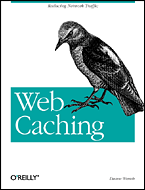Table of Content
| only for RuBoard - do not distribute or recompile |

Web Caching
Preface
Audience
What You Will and Won't Find Here
Caching Resources
Conventions Used in This Book
How To Contact Us
Acknowledgments
1. Introduction
1.1 Web Architecture
1.2 Web Transport Protocols
1.3 Why Cache the Web?
1.4 Why Not Cache the Web?
1.5 Types of Web Caches
1.6 Caching Proxy Features
1.7 Meshes, Clusters, and Hierarchies
1.8 Products
2. How Web Caching Works
2.1 HTTP Requests
2.2 Is It Cachable?
2.3 Hits, Misses, and Freshness
2.4 Hit Ratios
2.5 Validation
2.6 Forcing a Cache to Refresh
2.7 Cache Replacement
3. Politics of Web Caching
3.1 Privacy
3.2 Request Blocking
3.3 Copyright
3.4 Offensive Content
3.5 Dynamic Web Pages
3.6 Content Integrity
3.7 Cache Busting and Server Busting
3.8 Advertising
3.9 Trust
3.10 Effects of Proxies
4. Configuring Cache Clients
4.1 Proxy Addresses
4.2 Manual Proxy Configuration
4.3 Proxy Auto-Configuration Script
4.4 Web Proxy Auto-Discovery
4.5 Other Configuration Options
4.6 The Bottom Line
5. Interception Proxying and Caching
5.1 Overview
5.2 The IP Layer: Routing
5.3 The TCP Layer: Ports and Delivery
5.4 The Application Layer: HTTP
5.5 Debugging Interception
5.6 Issues
5.7 To Intercept or Not To Intercept
6. Configuring Servers to Work with Caches
6.1 Important HTTP Headers
6.2 Being Cache-Friendly
6.3 Being Cache-Unfriendly
6.4 Other Issues for Content Providers
7. Cache Hierarchies
7.1 How Hierarchies Work
7.2 Why Join a Hierarchy?
7.3 Why Not Join a Hierarchy?
7.4 Optimizing Hierarchies
8. Intercache Protocols
8.1 ICP
8.2 CARP
8.3 HTCP
8.4 Cache Digests
8.5 Which Protocol to Use
9. Cache Clusters
9.1 The Hot Spare
9.2 Throughput and Load Sharing
9.3 Bandwidth
10. Design Considerations for Caching Services
10.1 Appliance or Software Solution
10.2 Disk Space
10.3 Memory
10.4 Network Interfaces
10.5 Operating Systems
10.6 High Availability
10.7 Intercepting Traffic
10.8 Load Sharing
10.9 Location
10.10 Using a Hierarchy
11. Monitoring the Health of Your Caches
11.1 What to Monitor?
11.2 Monitoring Tools
12. Benchmarking Proxy Caches
12.1 Metrics
12.2 Performance Bottlenecks
12.3 Benchmarking Tools
12.4 Benchmarking Gotchas
12.5 How to Benchmark a Proxy Cache
12.6 Sample Benchmark Results
A. Analysis of Production Cache Trace Data
A.1 Reply and Object Sizes
A.2 Content Types
A.3 HTTP Headers
A.4 Protocols
A.5 Port Numbers
A.6 Popularity
A.7 Cachability
A.8 Service Times
A.9 Hit Ratios
A.10 Object Life Cycle
A.11 Request Methods
A.12 Reply Status Code
B. Internet Cache Protocol
B.1 ICPv2 Message Format
B.2 Opcodes
B.3 Option Flags
B.4 Experimental Features
C. Cache Array Routing Protocol
C.1 Membership Table
C.2 Routing Function
C.3 Examples
D. Hypertext Caching Protocol
D.1 Message Format and Magic Constants
D.2 HTCP Data Types
D.3 HTCP Opcodes
E. Cache Digests
E.1 The Cache Digest Implementation
E.2 Message Format
E.3 An Example
F. HTTP Status Codes
F.1 1xx Intermediate Status
F.2 2xx Successful Response
F.3 3xx Redirects
F.4 4xx Request Errors
F.5 5xx Server Errors
G. U.S.C. 17 Sec. 512. Limitations on Liability Relating to Material Online
H. List of Acronyms
I. Bibliography
I.1 Books and Articles
I.2 Request For Comments
Colophon
| only for RuBoard - do not distribute or recompile |